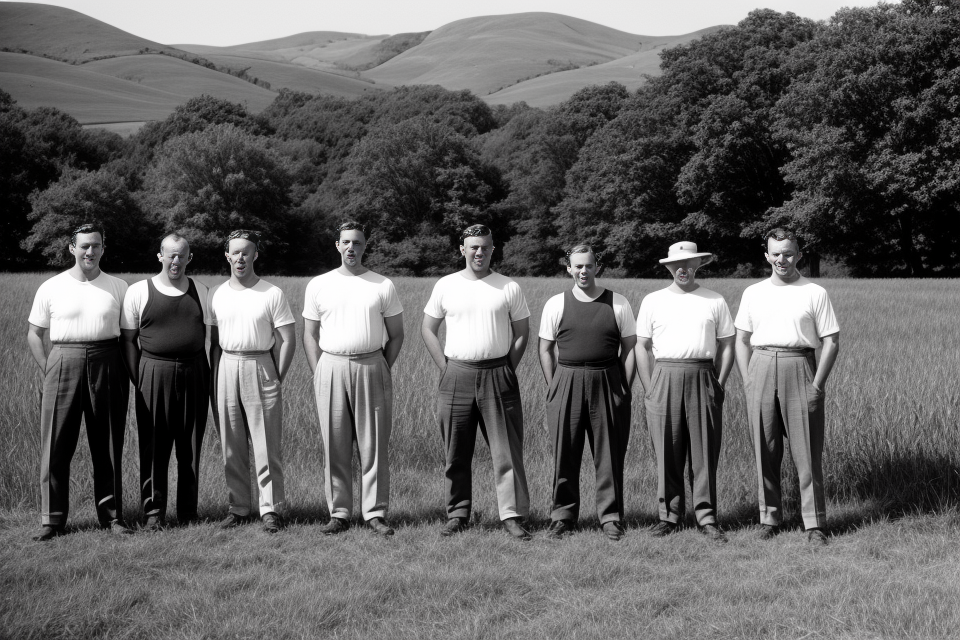The T-shirt, a wardrobe staple for many, has been a part of our lives for as long as we can remember. But have you ever wondered about its origins? Where did this simple yet versatile garment come from? In this article, we’ll delve into the history of the T-shirt and explore the question that’s been on everyone’s mind: Did T-shirts exist in 1920? Get ready to discover the fascinating story behind this iconic piece of clothing.
The origins of the T-shirt can be traced back to the early 20th century, but it is unclear whether they existed in 1920 specifically. The T-shirt as we know it today was popularized during World War II as a comfortable and practical garment for soldiers. However, there are some claims that the T-shirt was worn as early as the 1890s, making it possible that it existed in some form in 1920. The earliest known T-shirt was made of silk and worn by sailors in the late 19th century. Regardless of its exact origins, the T-shirt has become a staple garment in modern fashion and is widely recognized as a symbol of American culture.
The Evolution of the T-Shirt
The Early Years: From Union Suits to A-Shirts
The origins of the T-shirt can be traced back to the early 20th century when it was a part of the standard uniform for the U.S. Navy. However, the roots of the T-shirt can be traced back even further to the late 19th century when it was a part of the union suit, a one-piece undergarment worn by laborers.
The union suit was a common garment worn by working-class men during the late 19th and early 20th centuries. It was typically made of heavy wool or cotton and was designed to provide warmth and protection against the elements. The union suit was a practical garment that was often worn by men in a variety of professions, including farmers, railroad workers, and miners.
However, the union suit was not a particularly stylish garment, and as the 20th century progressed, there was a growing demand for more fashionable and comfortable clothing. This led to the development of the A-shirt, a garment that was similar to the union suit but was designed to be more fashionable and comfortable.
The A-shirt was first introduced in the early 1900s and was initially worn as a casual, everyday garment. It was typically made of a lighter fabric than the union suit and was designed to be more comfortable and breathable. The A-shirt quickly became popular among working-class men and was often worn as a casual, everyday garment.
Over time, the A-shirt evolved into the modern T-shirt, a garment that is now a staple of modern fashion. The T-shirt is a simple, versatile garment that can be worn in a variety of settings and is a popular choice for both men and women.
Despite its humble origins as a utilitarian garment for laborers, the T-shirt has become a fashion icon and a symbol of rebellion and individuality. Today, the T-shirt is a staple of modern fashion and is worn by people all over the world.
The 1920s: A Decade of Change for the T-Shirt
The 1920s was a decade of significant change for the t-shirt. This period saw the rise of new styles and designs that would shape the future of this iconic garment.
The Influence of Fashion on the T-Shirt
Fashion played a crucial role in the evolution of the t-shirt during the 1920s. As the hemlines rose and the waistlines dropped, the t-shirt emerged as a staple of the flapper’s wardrobe. The loose-fitting, short-sleeved top became a popular choice for women who wanted to show off their legs and dance the night away. The t-shirt also began to be worn as a casual, everyday garment, replacing the more formal blouse or shirtwaist.
The Rise of the Sports T-Shirt
Another significant development during the 1920s was the rise of the sports t-shirt. As sports became more popular, teams and athletes began to wear t-shirts as part of their uniforms. This was a practical choice as the t-shirt was lightweight and breathable, making it ideal for sports and exercise. The sports t-shirt also became a fashion statement, with teams and brands using them to promote their identities and logos.
In conclusion, the 1920s was a decade of change for the t-shirt. Fashion trends and the rise of sports culture helped to popularize the garment, solidifying its place in the wardrobes of both men and women. The t-shirt had come a long way from its origins as a basic, undergarment, and was now a staple of casual, everyday wear.
The 1920s: A Turning Point for the T-Shirt
The Fashion Trends of the 1920s
The 1920s were a pivotal period in the history of fashion, particularly in relation to the T-shirt. The decade witnessed significant changes in the way people dressed, with new styles emerging that would come to define the era. Two key trends that had a profound impact on the T-shirt were the flapper style and the emergence of the sports T-shirt.
The Impact of Flapper Style on the T-Shirt
The flapper style, which became popular in the 1920s, was characterized by short, loose-fitting dresses that exposed the arms and shoulders. This new style of dress was a departure from the more conservative fashions of the previous decade, and it had a profound impact on the T-shirt. The loose-fitting dresses of the flapper style were often worn with a T-shirt-like garment underneath, which accentuated the waist and gave the illusion of a longer, slimmer silhouette. The T-shirt thus became an essential component of the flapper look, and its popularity soared as a result.
The Emergence of the Sports T-Shirt
Another key trend that emerged in the 1920s was the rise of sportswear. With the growing popularity of sports such as tennis and golf, there was a growing demand for clothing that was designed specifically for athletic activities. The T-shirt, with its simplicity and comfort, was an ideal garment for sportswear, and it quickly became a staple of the sports wardrobe. The first sports T-shirts were made of lightweight, breathable fabrics such as cotton or silk, and they were often worn with shorts or trousers for a complete sports look.
In conclusion, the 1920s were a turning point for the T-shirt, with new styles and trends emerging that would come to define the era. The flapper style and the rise of sportswear both had a profound impact on the T-shirt, making it an essential component of many people’s wardrobes. As a result, the T-shirt began to evolve from a simple undergarment into a versatile and fashionable garment that could be worn in a variety of settings.
The Popularity of the T-Shirt in the 1920s
The 1920s marked a significant turning point in the history of the t-shirt. The decade saw a surge in the popularity of the garment, as it transitioned from being a functional undergarment to a fashionable casual wear item. This shift can be attributed to several factors, including the growing acceptance of the t-shirt as a casual garment and the impact of advertising on its popularity.
The Growing Acceptance of the T-Shirt as a Casual Garment
During the 1920s, the t-shirt began to shed its reputation as a strictly utilitarian garment and gained acceptance as a casual wear item. This change can be attributed to several factors, including the increasing popularity of sports and leisure activities, which created a demand for comfortable, breathable clothing. The t-shirt’s simplicity and practicality made it an ideal choice for everyday wear, and its increasing availability in department stores and clothing catalogs helped to further legitimize it as a fashionable garment.
The Impact of Advertising on the T-Shirt’s Popularity
Advertising played a significant role in the t-shirt’s rise to popularity during the 1920s. Companies began to recognize the marketing potential of the garment, and they began to feature the t-shirt in their advertisements. This increased exposure helped to raise the t-shirt’s profile and make it a more visible and desirable item of clothing. In addition, advertisements often featured celebrities and public figures wearing t-shirts, further fueling the garment’s popularity.
The growing acceptance of the t-shirt as a casual garment and the impact of advertising on its popularity helped to establish the t-shirt as a fashionable and versatile item of clothing during the 1920s. This marked a significant turning point in the history of the t-shirt, as it transitioned from being a purely functional undergarment to a fashionable and popular item of casual wear.
Did T-Shirts Exist in 1920?
The Evidence for the Existence of T-Shirts in the 1920s
The Availability of Early T-Shirts
One of the primary pieces of evidence that supports the existence of t-shirts in the 1920s is the availability of early t-shirts. While the exact origins of the t-shirt are difficult to pinpoint, it is believed that they were first introduced as a form of undergarment for American servicemen during World War I. The t-shirt’s simplicity and practicality made it an ideal garment for soldiers, who needed a comfortable and functional piece of clothing that could be easily worn under their uniforms.
The availability of early t-shirts in the 1920s can also be seen in the advertisements and catalogs of the time. Companies such as J.C. Penney and Sears, Roebuck and Co. began to offer t-shirts as part of their product lines, suggesting that they were becoming a more widely recognized and accepted form of clothing.
The Presence of T-Shirts in Popular Culture
Another piece of evidence that supports the existence of t-shirts in the 1920s is their presence in popular culture. While t-shirts were initially used as a form of undergarment, they began to be worn as a casual, everyday garment during the 1920s. This shift in how t-shirts were perceived can be seen in the images of the time, which often depict men wearing t-shirts as part of their everyday attire.
In addition to their use as a casual garment, t-shirts also began to be used as a form of advertising and promotional material during the 1920s. Companies would often print their logos or slogans on t-shirts and give them away as promotional items at events or as part of product bundles. This practice, which is still common today, suggests that t-shirts were becoming an increasingly popular form of clothing and a useful marketing tool.
Overall, the evidence for the existence of t-shirts in the 1920s is supported by their availability in early advertisements and catalogs, as well as their presence in popular culture as a casual, everyday garment. While the exact origins of the t-shirt may be difficult to pinpoint, it is clear that they were a recognizable and accepted form of clothing during the 1920s.
The Theories on the Origin of the T-Shirt
The Marine Theory
The Marine Theory suggests that the T-shirt originated from the U.S. Navy during the early 20th century. The sailors wore a simple, short-sleeved, white cotton undershirt as a casual garment, which eventually became a part of their uniform. This theory is supported by the fact that the term “T-shirt” is derived from the T shape of the garment, with short sleeves and a round neckline.
The Polo Theory
The Polo Theory proposes that the T-shirt was first worn by polo players in the early 1900s. The players needed a comfortable, breathable garment that would allow them to move freely during the game. The T-shirt, with its simple design and lightweight fabric, was perfect for this purpose. This theory is supported by the fact that the T-shirt became popular in the United States during the 1920s, a time when polo was gaining popularity as a sport.
Overall, both theories have their own merits, and it is possible that the T-shirt may have originated from both sources. However, without concrete evidence, it is difficult to determine the exact origin of the T-shirt.
The Future of the T-Shirt
The Evolution of the T-Shirt into a Wardrobe Staple
The Continued Popularity of the T-Shirt
Despite its humble beginnings as a undergarment for American sailors, the t-shirt has since become a staple in many people’s wardrobes. The simplicity and versatility of the t-shirt make it a popular choice for both casual and formal occasions.
One reason for the continued popularity of the t-shirt is its versatility. It can be dressed up or down, making it a versatile piece of clothing that can be worn to a variety of events. Whether paired with jeans and sneakers for a casual look or dressed up with a blazer and dress pants for a more formal occasion, the t-shirt is a wardrobe essential that can be worn by anyone, anywhere.
The Influence of Celebrities and Pop Culture on the T-Shirt
The t-shirt has also become a popular medium for self-expression and fashion statements. Many celebrities and influencers have been seen wearing t-shirts with slogans or graphics that reflect their personal beliefs or style. This has led to a surge in popularity for statement t-shirts, which have become a staple in many people’s wardrobes.
In addition to being a popular medium for self-expression, the t-shirt has also become a symbol of pop culture. Many iconic images and slogans from movies, TV shows, and music have been featured on t-shirts, making them a popular choice for fans of these cultural touchstones. The t-shirt has become a way for people to show their love for their favorite movies, TV shows, and music, and has become an important part of pop culture.
In conclusion, the t-shirt has come a long way since its origins as a simple, utilitarian garment for American sailors. Today, it is a wardrobe staple that is both versatile and stylish, and has become a popular medium for self-expression and fashion statements. Whether dressed up or down, the t-shirt is a timeless piece of clothing that will continue to be a staple in many people’s wardrobes for years to come.
The Impact of Technology on the T-Shirt
The Advancements in Textile Technology
In recent years, there have been significant advancements in textile technology that have impacted the t-shirt. For example, new fabrics have been developed that are stronger, more durable, and have a longer lifespan than traditional cotton t-shirts. Additionally, innovative printing techniques have allowed for more intricate designs and patterns to be incorporated into t-shirts, making them more visually appealing.
The Influence of Sustainable Fashion on the T-Shirt
Sustainable fashion has also had a significant impact on the t-shirt. With growing concerns about the environmental impact of the fashion industry, many consumers are turning to sustainable fashion options. This has led to the development of eco-friendly t-shirts made from organic cotton, recycled materials, and other sustainable fabrics. These t-shirts are not only better for the environment but also often have a longer lifespan than traditional t-shirts, making them a more sustainable option for consumers.
As technology continues to advance and sustainability becomes an increasingly important concern, it is likely that the t-shirt will continue to evolve and change. With new materials, printing techniques, and design options, the t-shirt is likely to remain a staple in the fashion industry for years to come.
FAQs
1. What is a T-shirt?
A T-shirt is a type of shirt that has a T-shaped design with short sleeves and a round neckline. It is typically made of a lightweight, breathable fabric such as cotton, and is often worn as a casual, everyday garment.
2. When was the T-shirt invented?
The T-shirt as we know it today was first introduced in the early 20th century, and it has evolved significantly since then. However, the origins of the T-shirt can be traced back even further. The earliest known T-shirt-like garment was a simple, one-piece garment worn by ancient Egyptians, which was made of linen and had a T-shaped design.
3. Did T-shirts exist in 1920?
Yes, T-shirts did exist in 1920. However, they were not as common as they are today. At the time, T-shirts were primarily worn as undergarments or as part of uniforms for sports teams and the military. They were not yet considered a fashionable item of clothing for everyday wear.
4. How have T-shirts evolved over time?
T-shirts have evolved significantly over the years. In the early 20th century, T-shirts were often made of heavy, coarse fabrics and were worn as a type of undergarment or workwear. However, as the fashion industry evolved, T-shirts became more popular as a casual, everyday garment, and they were made from lighter, more breathable fabrics such as cotton. Today, T-shirts are a staple item of clothing for many people and are often worn as a fashion statement.
5. Who popularized the T-shirt?
The T-shirt became a popular item of clothing in the mid-20th century, thanks in part to its association with the military and sports teams. However, it was not until the 1950s that the T-shirt became a popular fashion statement. At the time, Hollywood celebrities and other famous figures were often seen wearing T-shirts, which helped to make the garment more fashionable and desirable.



